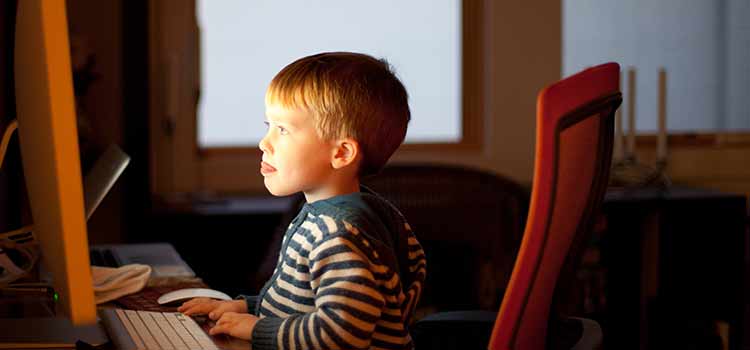Potential deficits of virtual learning like excessive screen time can be ameliorated.
Like many parents I know, I fret over the time children spend looking at computer monitors, cell phones, tablets, and the TV. When our three kids were young, my wife and I set screen time limits. Medical evidence suggested that interacting with digital devices for long periods could affect sleep, vision, concentration, and even obesity. But we also just wanted our kids to stay engaged with the people and places around them.
I’d rather walk in the woods than look at a screen, but I’m no stranger to a laptop, message app, tweet, or Netflix. I constantly work to maintain a balance between the real world and virtual worlds. Young people may not care about such a choice, but they should realize they have it. I am relieved that my adult children choose to spend at least as much time outdoors, interacting with people in person, as in digital spaces.
Is there such a thing as good screen time?
According to Dr. Michael Rich of Boston Children’s Hospital and Harvard Medical School, “It’s not how long we’re using screens that really matters; it’s how we’re using them and what’s happening in our brains in response.” There’s a world of difference between Roxblox and Mister Rogers.
Educational screen experiences can be made more or less enriching. As with in-person instruction, digital lessons can be passive– watching a video, for example– or active, like solving physics problems with digital manipulatives or interacting with peers in a vibrant virtual space.
Recent articles in the New York Times and the Washington Post looked at the surge in children’s screen time, both academic and recreational, during and after pandemic quarantines. Each likened the possible aftermath to recovering from addiction. Another WaPo article fretted that students will have a hard time returning to face-to-face learning after the freedoms of remote classes.
A second article in the Times four days later described possible benefits of being online, including, for some children, improved communication, personalization of learning, and increased fluency with needed tech skills. Guidance from UNICEF suggests that online activities, including games, can increase social engagement. We shouldn’t look at this as an and/or, good/bad situation any more than we should try to ban all carbs from our meals.
For some students, it’s been either remote learning or no learning.
After decades on the outskirts, digital learning clearly gained a foothold in P-12 education this year. Even when students return to physical classrooms, it will still likely be used for remediation, enrichment, advancement, homebound instruction, and to fill gaps in our curriculum. Augmenting in-person classes, this could be an important tool we’ve gained.
As we step forward, let’s think carefully about this new habit. There is much we don’t know about the longer term impact of the pandemic on habits and health, but we can start planning a balanced education model that works well both online and offline.
Here is how some educators have begun addressing the screen time issue:
1. Break up virtual class time. Whatever schedule your school has chosen, more than 40 minutes looking at a computer screen (even less if they’re younger) is difficult to maintain. Use a variety of methods and media in each lesson. Use whole group for pulse taking and brainstorming. Pop in to support small group work sessions. Create self paced activities. Every 15-20 minutes, take eye and brain breaks that can be a no-work 60 second stretch or going off screen to jot, sketch, think, look for, etc.
2. Maximize quality time spent online. In “flipped” instruction, students are exposed to content offline, then make the most of live virtual meetings to discuss and apply what they’ve learned. Woven throughout these precious minutes is time dedicated to socialization, mental health, and communication skills. And rather than jamming a day of lessons into a couple of hours, teachers are collaborating to focus the curriculum on what’s most important.
3. Send students into the real world. Using common materials and interacting with spaces in their kitchen, bedroom, or yard not only provide a break from screens but help students connect virtual with real. Students’ home conditions vary broadly, of course, so ask for what can easily be found (e.g. find five round objects less than three inches in diameter).
4. Go hands on. Use those found objects from above as math manipulatives or for atomic model building. Design authentic project guidelines/rubrics that allow for physical builds, with paper, cardboard, legos, duct tape, etc. Students then present or snap a pic of the result to share and discuss.
5. Give eyes a rest. For variety and to look away from screens, there are many opportunities to have students use their ears, like listening to clips from podcasts, TEDtalks, songs, and book readings.
6. Get physical! You don’t have to be a PE teacher to incorporate movement into and/or as a break from the lesson. Whenever I’m at my computer, I set a timer for 30 minutes and jump around or walk up and down the stairs when it goes off.
 Educators and parents often talk about challenges as “teachable moments.” What we want the child to learn is how to meet future challenges with greater wisdom, confidence, and perspective. This is one of those moments.
Educators and parents often talk about challenges as “teachable moments.” What we want the child to learn is how to meet future challenges with greater wisdom, confidence, and perspective. This is one of those moments.
I am greatly anticipating the day when we can look into each other’s faces rather than at screens!
⚙ Dr. Marc
October 31, 2022 Update FYI: data suggest remote learning has not been the cause of learning setbacks during the pandemic! https://www.chalkbeat.org/2022/10/28/23429271/learning-loss-remote-learning-high-poverty-schools-harvard-stanford-research
If you have a friend or colleague who speaks this kind of language, or would benefit from hearing it, feel free to forward this post.
©2021 Marc Natanagara, Ed.D. All rights reserved. Reprinted with permission.
This article and other resources available at authenticlearningllc.com
When duplicating this post in any form, please make sure to include the attribution above.
January 27, 2021
Image: Lars Plougmann, Creative Commons CC-BY-SA





